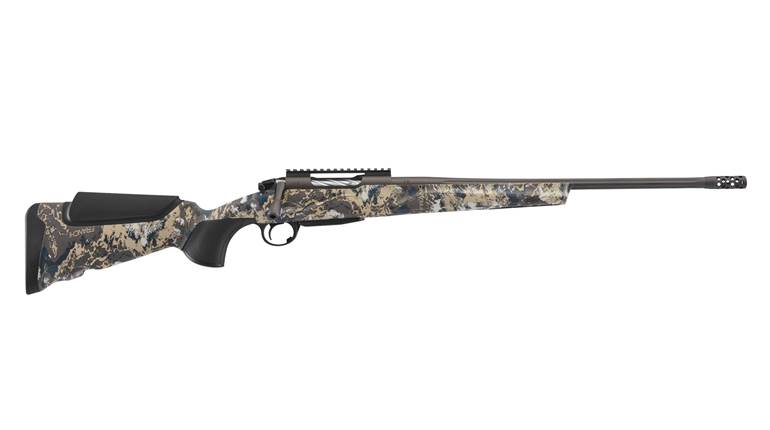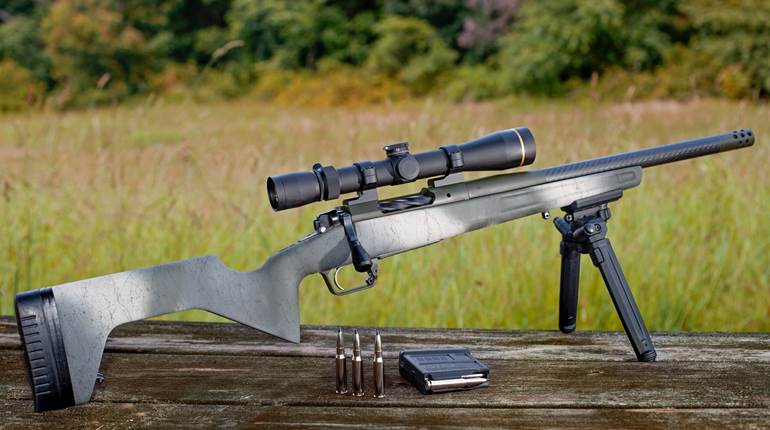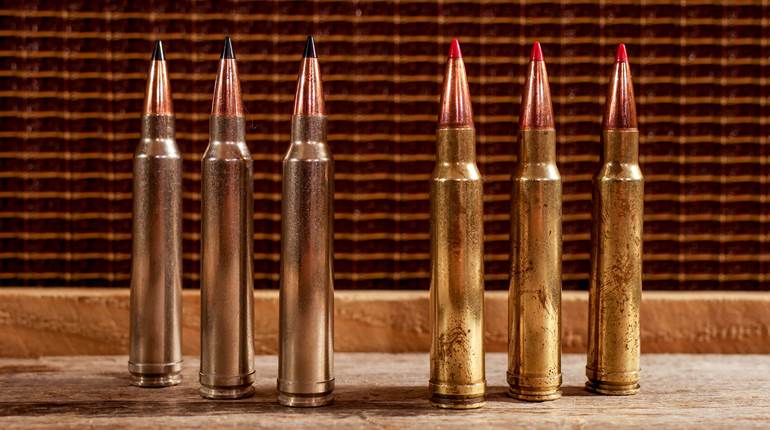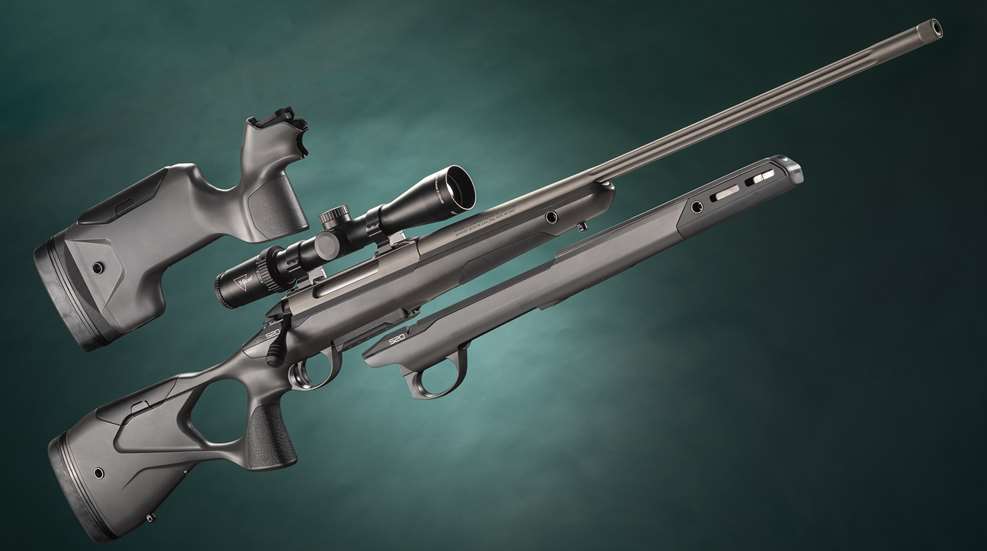
The early 20th century was a tumultuous time. In 1918, Finland found itself embroiled in a civil war. On one side was the Soviet-backed Social Democratic Party, the “Reds,” who sought to bring about their own communist revolution. On the other side were the German-backed “Whites,” consisting primarily of White Guard militia units and German-trained Jäger infantry.
The “Whites” won the war in May 1918, and the young independent nation of Finland needed a way to arm and re-supply its growing Civil Guard without much of a budget. The General Staff Arms Factory stood up an armory with the task of refurbishing thousands of leftover Russian M1891 Mosin-Nagant rifles. That armory eventually became known as the Firearms and Machine Workshop of the Civil Guard, which, in Finnish, reads Suojeluskuntain Ase- ja Konepaja Osakeyhtiö—or Sako for short.
From the time Sako became independent in 1921, it passed through a series of owners—including the Finnish Red Cross, Nokia (yes, that Nokia), Valmet and the Beretta Group of today. Through it all, it has sought to maintain the spirit of the Civil Guard that it served by honoring the strong hunting and outdoor culture of Finland.
The Evolution Of Design
Sako started by refurbishing old Russian Mosins, but soon ventured into engineering its own improvements. For example, the M/28 Pystykorva featured improved front sights, while the next iteration, the M/28-30—used by famed Finnish World War II sniper Simo Häyhä—featured a further improved rear sight. With every design, lessons learned from previous guns were carried forward into future models. For example, the L46 marked Sako’s break into the U.S. market; it shared much in common with the Mauser, including the long and thin extractor design. The L57 released 11 years later featured a shorter and wider “Sako-style” extractor. This design is simple but effective, consisting of an extractor hook, plunger and spring assembly, and is considered to be a desirable feature today.
The next evolution came in 1989 with the legendary TRG-21 and TRG-41 rifles. These target rifles featured a three-lug bolt design allowing for a shorter, 60 degree throw. This helped with faster cycling of the action. The TRG action also bolted to an internal aluminum skeleton for increased rigidity and accuracy. The Sako 85 came in 2006, an evolution of the earlier Sako 75, and featured the same three-lug bolt design as the TRG and a new safety mechanism separating the firing mechanism from the ability to unload the rifle.
In 2008, Sako released the A7, representing a middle price point between the high-end Sako 85 and the Tikka T3 line—Tikka having become Sako’s sister company in 1983. In 1989, operations at the original Tikkakoski plant transferred to Sako’s facility in Riihimäki. Tikka rifles take advantage of manufacturing efficiencies and strategic use of polymer to reach a lower price point. The A7 borrowed elements from the T3—such as the use of polymer in low-stress points and a drilled-and-tapped receiver rather than machined scope rails and other small details.
From the Sako 85 came a two-position safety with a separate cocking-release button. Sako discontinued the A7 in the United States a few years later, and the S20 evaluated here represents a modernized replacement.

Breaking New Ground
Sako released the S20 in February 2020 as its first true hybrid rifle; it allows users to quickly switch between a hunting configuration and a precision-rifle configuration. Design aspects aside, one of the key differences to an American gun-buying audience is that the S20 costs significantly less than other current Sako models. As of this writing, the S20 has an MSRP of $1,699. In comparison, the Sako 85, the company’s premier contemporary hunting rifle, can go for $2,500 or more, and the renowned TRG-22 and TRG-42 precision rifles can cost in excess of $3,000.
Elements from previous Sako models clearly influence the S20. For example, the S20 attaches to an internal aluminum-chassis design with three bolts, as first seen on the TRG series, which contributes to its modularity. The S20 borrows its safety design from Sako’s 85. It’s a simple two-position safety with a small lever just in front of the switch that allows the bolt to open and cycle, ejecting any live or spent cartridges, while also keeping the firing pin block and trigger safety engaged. It’s an elegant design that seems more refined than a three-position safety.
Like the A7, the S20 also shows influences from Tikka’s product line, whereby the S20 only has one action length, regardless of its chambering. The difference between a short action, a long action or a magnum action is the use of different bolt stops that limit bolt travel. Also, like the Tikka T3x series, the recoil lug of the S20 is located in the chassis system, inserted into a machined recess of the action.
The S20 has machined Picatinny rails at the front and rear of the action rather than the dovetails Sako typically uses on its hunting rifles. The rails themselves have no elevation built in, which may be a concern for long-range shooters, but Sako offers a scope base with a 20-m.o.a. cant—however, it only works with Sako’s own Optilock rings.
The stainless-steel bolt features three locking lugs and a 60-degree bolt throw during cycling. A Sako-style extractor once again makes an appearance. The ejector is a plunger style, as found on the TRG, A7 and Tikka models. I found the bolt to be among the smoothest operating I’ve ever encountered in a factory rifle. The teardrop bolt handle shape is reminiscent of many tactical-style handles on the market, though shorter and smaller.

My sample model came with a single-stage trigger averaging 2 lbs., 13 ozs., from the factory across 10 pulls with a Timney trigger gauge. The pull weight is user-adjustable from 2 to 4 lbs. and is also adjustable for trigger reach. The single-stage trigger of my test sample displayed zero creep, grittiness or anything of the sort; it is easily one of the finest factory triggers on the market. Sako also offers a two-stage trigger for those who prefer it.
The S20’s stock does not have a magazine release. Instead, the release is on the front of the magazine itself, tucked up into a 0.4"-deep recess on the bottom of the stock to help prevent snagging. Magazine engagement is positive, with a satisfying click as it slides into place. My .300 Win. Mag.-chambered sample came with one three-round polymer magazine, but Sako has optional seven-round magazines available as well. Non-magnum chamberings have both five- and 10-round magazines.
The magazine has a length accommodation of 3.608". Since Sako uses the same action size for all cartridges, magazines designed for short-action chamberings use a spacer at the rear to fill the gap. As of this writing, Sako S20 magazines are available for between $29 and $39, making them far more affordable than many other precision rifle offerings. I hope to see this design become more common, however, like other similar options—such as the ubiquitous AICS pattern—you cannot “top off” a magazine while it is inserted into the rifle.

The 24" cold-hammer-forged, stainless-steel barrel on the sample S20 has six deep flutes and 5/8x24 TPI muzzle threads capped with a knurled, metal thread protector. The barrel sports a 1:10" twist rate and tapers down to 0.735" at the muzzle. Tungsten-colored Cerakote covers both the barrel and the action.
My test sample was the Hunter model, as opposed to the Precision model. The spec sheet lists its weight at 7 lbs., 6 ozs., unloaded, though my scale showed it heavier at 8 lbs., 1 oz. The stock feels narrow, sleek and devoid of anything likely to snag on brush. The fore-end measures 1.65" at the action and tapers down to 1.54" at the front sling swivel. It has little-to-no flex, owing to the aluminum chassis underneath it, and the barrel is free-floated. The stock measures 1.55" in width at the adjustable comb and 1.03" at the bottom, creating an obvious V-taper.
The grip on the Hunter model is a thumbhole design that I found to be very comfortable as a right-handed shooter. Sako molded in a thumb rest along the left side, which appears as a graceful ridge. However, this ridge gets in the way of shooting left-handed, so I think the Precision model of the S20 would be more appropriate for left-handed shooters. Patches of rubberized material cover the contact spots on the fore-end and pistol grip.
A hard plastic cheekpiece offers six positions of height adjustment. The bottom setting is flush with the rest of the stock, and the top position adds about 1.25" in comb height. You make adjustments by pinching a lever built into the right side and sliding the cheekpiece up or down. I noticed the bolt cannot be removed with the cheek piece any higher than the first position.
The S20 Hunter came from the factory with two 8 mm spacers installed between the stock and the recoil pad. From the factory, I measured the length of pull (LOP) at about 14"; adding or removing spacers allows the user to adjust the LOP to between 13.75" and 14.25". The spacer system, along with adjusting the position of the trigger shoe, offers a lot of ability for users to fine-tune the feel of the rifle. The overall length of the 24"-barreled sample rifle from the factory, with two spacers installed, came in at 45.25". Lastly, the S20 Hunter stock features sling swivel studs on the bottom at the front and rear position, as well as non-rotation-limiting QD sling sockets on the left and right of the front and rear.
In all, the stock feels solid but “plasticky,” although it is apparent that it is made of a quality polymer—like the kind found on high-end AR-15 stocks—and certainly more sturdy than the plastic stocks that come with budget-friendly rifles. For those who love the traditional look and feel of wood, or the high-end feel of fiberglass, this is likely a drawback. On the other hand, if you’re accustomed to shooting rifles with polymer furniture, this will feel familiar.
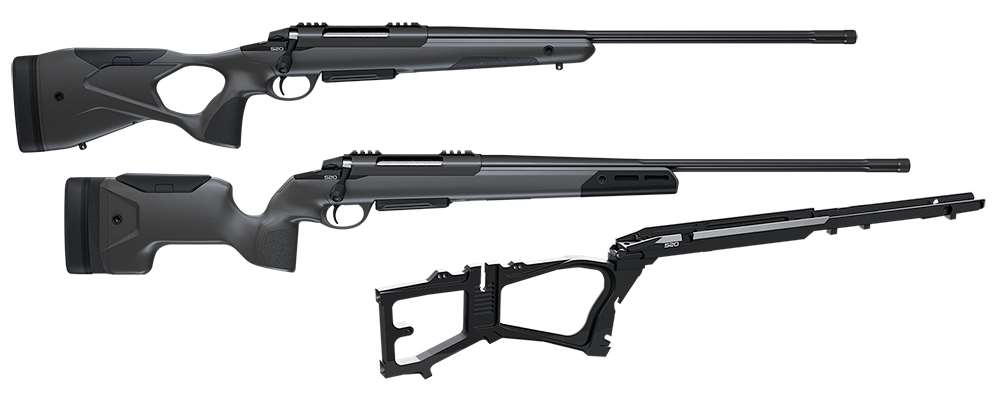
The Hybrid Feature
Everything I’ve described so far represents the hunting model. What about the precision model? The core components of the rifles, consisting of the barreled action and chassis, are identical. The difference is in the external polymer stock components. By removing a few T25 Torx screws holding the stock components to the chassis, you can swap the fore-end and buttstock independently—even mix and match them to your personal preference.
The precision stock, which was not available for me to test, is a more traditional tactical rifle stock with a hooked bottom, wider grip surface and thumb shelves on the top side of the grip. The precision fore-end is wider, boxier and better suited for riding on bags. It also features three M-Lok slots along the bottom front, with an additional one closer to the magazine well and two on each side for mounting a variety of accessories. The precision rear stock also has an M-Lok slot on the bottom for a monopod, along with a recoil pad adjustable for both length of pull and height.
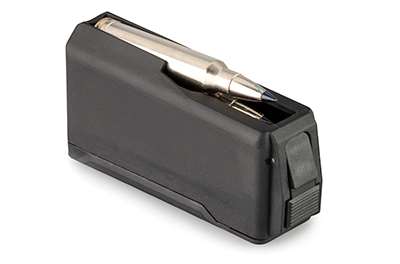
Putting It To Use
Out of the box, my .300 Win. Mag. Sako S20 Hunter came fully assembled, along with a lock, manual, small bag of sling swivels, sticker and one three-round magazine. The rifle balanced at the front of the magazine, just under the release button. For positional shooting and a general-purpose kind of rifle, this is exactly where I want it to be.
I mounted a Steiner P4Xi 4-16X 56 mm scope via a set of 34 mm Vortex Precision Match Rings. My particular rings are 1.1" tall and offered just barely enough clearance for the 56 mm objective sitting over the chamber. Smaller objectives would obviously provide more clearance. Even with nearly 2 lbs., 8 ozs., of optic and mount attached to the top, the S20 maintained a composed feeling in the hands and took to positions well. The balance point remained just in front of the magazine well. With a sling, the S20 nimbly moved into position and settled in well.
For testing, I brought along three .300 Win. Mag. loads: Federal Premium’s 185-grain Hybrid Hunter, Hornady’s 200-grain Precision Hunter and Winchester’s 150-grain Deer Season XPs. Accuracy testing took place on a separate day on an indoor range. Per Rifleman’s standard testing procedures, I fired five, five-shot groups at 100 yards for each load with the rifle mounted on a Vortex Radian tripod with a Shadow Tech Pig saddle. The best-performing ammunition was the Federal Hybrid Hunter, which turned in an average group of 0.98". For a factory rifle at this price point not fired from a machine rest, this is a fantastic level of accuracy.
Through all of it, the Sako S20 Hunter happily fed from the magazine or when single-loaded without any sort of malfunction. The bolt moved smoothly, required no undue effort to manipulate and ejected every spent case without a complaint. It was a pleasure to shoot—the trials of shooting more than 75 rounds of .300 Win. Mag. through a lightweight rifle in a single session notwithstanding.
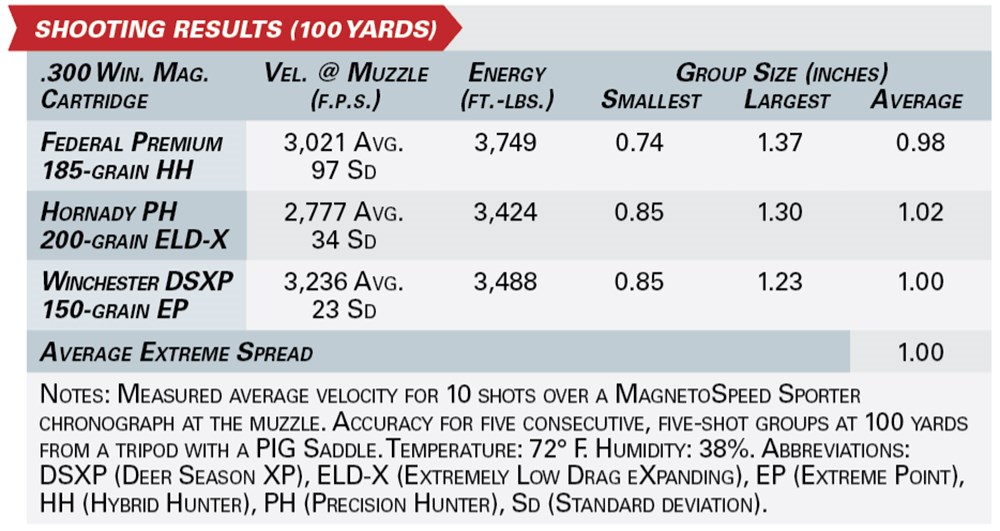
Final Thoughts
This rifle occupies an interesting place in the market. On one hand, it fills the hole left by the discontinued A7 by putting Sako within reach of many shooters who would otherwise not have considered a rifle in the $2,000-plus price bracket. It does that with some great design touches and is available in eight of the most popular hunting and target-shooting chamberings. On the other hand, it’s well-known that sister company Tikka’s T3x series occupies a similar price point (if not slightly lower for many models) and has several fantastic offerings using many of the same components produced on the same machines.
So why would I suggest purchasing an S20 Hunter over something like a Tikka T3x? I think the answer comes down to what you plan to do with the rifle after you purchase it. If you’re the kind of person who wants to tinker, invest in aftermarket chassis systems and customize a rifle to the point that it barely resembles the original rifle it started as—then I think the Tikka T3x may be a better fit for you. Going that route means spending several hundred (to a few thousand) additional dollars on all of those parts to match what the S20 could have brought from the start. But if you want to buy a “one-and-done” rifle that you can trust to deliver top-quality craftsmanship, accuracy and capability out of the box without the need to further customize it, the Sako S20 Hunter seems like a fantastic choice.












